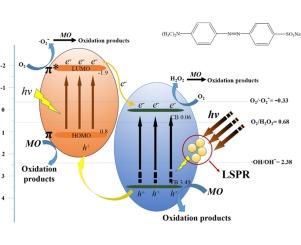- 【Applied Catalysis B】Fabrication of hollow mesoporous SiO 2-BiOCl@ PANI@ Pd photocatalysts to improve the photocatalytic performance under visible light
- 来源:张秋禹教授个人网站 2017-06-07

A facile method was developed to synthesize a series of hollow mesoporous SiO2-BiOCl@PANI@Pd (HBPP) photocatalysts with super adsorption performance, plasmonic effect and fast interfacial charge migration. The samples were characterized by XRD, FETEM, FT-IR, XPS, DRS, etc. Photocatalytic degradation of methyl orange (MO) by HBPP composites was investigated.
Results showed that the photocatalytic property of HBPP composite was superior to that of hollow mesoporous SiO2-BiOCl@PANI (HBP) composite under visible light irradiation, and the HBPP5wt% photocatalyst synthesized under 140 °C exhibits the highest photocatalytic activity. In this photocatalysis system, the orderly mesoporous opening structure of the hollow mesoporous SiO2 sphere could effectively facilitate the transfer of reactant molecules, and the existence of the internal cavities would effectively prolong the action time of the irradiated light for the multiple reflections. Moreover, the formation of interacted interfaces between the semiconductor BiOCl and conducting polymer (polyaniline) could effectively improve the separation of the photogenerated electron-hole pairs, and the palladium nanoparticles (Pd NPs) with strong localized surface plasmon resonance (LSPR) absorption band in the near-UV region could effectively induce the generation of the photoexcited electron-hole pairs in BiOCl, thus the as-obtained photocatalyst exhibits superior photocatalytic activity under visible light irradiation. The work may set foundation for application of the new photocatalyst of HBPP-based LSPR and make an important step forward remedying environmental pollution.
- [来源:中国聚合物网]
- 了解更多请进入: 张秋禹教授个人网站
- · 【Nano Research】A series of nanoparticles with phase-separated structures by 1,1-diphenylethene controlled one-step soap-free emulsion copolymerization and their application in drug release
- · 【Journal of Materials Chemistry A】Morphology-Dependent Electrochemical Supercapacitors in Multi-Dimensional Polyaniline Nanostructures
- · 【Polymer Chemistry】Large-Scale Fabrication of Polymer Ellipsoids with Controllable Patches via Viscosity-Induced Deformation of Spherical Particles
- · 【Polymer Chemistry】Preparation of Mechanoresponsive Hairy Particles Using Polymeric Surfactants in Emulsion Polymerization